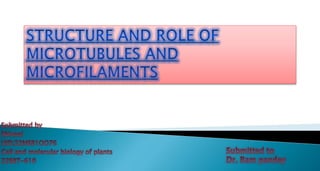cell and molecular biology PPT.pptx
•Download as PPTX, PDF•
0 likes•52 views
Three Elements of cytoskeleton : microtubules intermediate filaments microfilaments
Report
Share
Report
Share

Recommended
Recommended
More Related Content
Similar to cell and molecular biology PPT.pptx
Similar to cell and molecular biology PPT.pptx (20)
Describe the parts of the cytoskeleton and what role do they play. S.pdf

Describe the parts of the cytoskeleton and what role do they play. S.pdf
Recently uploaded
Molecular and Cellular Mechanism of Action of Hormones such as Growth Hormone, Prolactin, InsulinMolecular and Cellular Mechanism of Action of Hormones such as Growth Hormone...

Molecular and Cellular Mechanism of Action of Hormones such as Growth Hormone...Ansari Aashif Raza Mohd Imtiyaz
Recently uploaded (20)
Nanoparticles for the Treatment of Alzheimer’s Disease_102718.pptx

Nanoparticles for the Treatment of Alzheimer’s Disease_102718.pptx
Manganese‐RichSandstonesasanIndicatorofAncientOxic LakeWaterConditionsinGale...

Manganese‐RichSandstonesasanIndicatorofAncientOxic LakeWaterConditionsinGale...
POST TRANSCRIPTIONAL GENE SILENCING-AN INTRODUCTION.pptx

POST TRANSCRIPTIONAL GENE SILENCING-AN INTRODUCTION.pptx
Mining Activity and Investment Opportunity in Myanmar.pptx

Mining Activity and Investment Opportunity in Myanmar.pptx
Costs to heap leach gold ore tailings in Karamoja region of Uganda

Costs to heap leach gold ore tailings in Karamoja region of Uganda
Information science research with large language models: between science and ...

Information science research with large language models: between science and ...
Efficient spin-up of Earth System Models usingsequence acceleration

Efficient spin-up of Earth System Models usingsequence acceleration
ANITINUTRITION FACTOR GYLCOSIDES SAPONINS CYANODENS

ANITINUTRITION FACTOR GYLCOSIDES SAPONINS CYANODENS
Molecular and Cellular Mechanism of Action of Hormones such as Growth Hormone...

Molecular and Cellular Mechanism of Action of Hormones such as Growth Hormone...
Factor Causing low production and physiology of mamary Gland

Factor Causing low production and physiology of mamary Gland
cell and molecular biology PPT.pptx
- 2. “Cytoskeleton is the structure that maintains the shape and internal organization of the cell, and provides it mechanical support. “ The cytoskeleton is a complex network of protein fibers found in the cytoplasm of cells. It provides shape, support, and movement to cells.
- 3. A cytoskeleton structure comprises the following types of fibres : Microfilaments Microtubules Intermediate Filaments
- 4. Microfilaments, also known as actin filaments, are one of the three main types of fibers that make up the cytoskeleton of cells. They are the thinnest fibers, with a diameter of about 7 nm. Microfilaments are composed of the protein actin, which can polymerize to form long chains. Microfilaments are involved in a variety of cellular processes, including cell movement, cell division, and maintaining cell shape and structure.
- 5. Microfilaments also play a role in cell signaling, as they can interact with proteins such as myosin and other actin-binding proteins to regulate cell behavior. Abnormalities in microfilaments can lead to a variety of diseases and disorders, including cancer, autoimmune diseases such as lupus, and genetic disorders such as Wiskott-Aldrich syndrome.
- 6. Microtubules is most crucial cytoplasm element responsible for maintaining the shape of the cell ,involved in cell division, responsible for locomotion in lower organisms ,cellular movements as well as responsible for attachment to the cell of substratum. They are long, hollow tubes made up of the protein tubulin, and they have a diameter of about 25 nanometers.
- 7. Microtubules also play a role in cilia and flagella, which are structures that extend from the surface of cells and are involved in movement and sensing. Abnormalities in microtubules can lead to a variety of diseases and disorders, including cancer, neurodegenerative diseases such as Alzheimer's and Parkinson's, and genetic disorders such as tuberous sclerosis complex.
- 8. They are thicker than microfilaments but thinner than microtubules, with a diameter of about 10 nanometers. Intermediate filaments are composed of a family of proteins called keratins, vimentin, desmin, and others, depending on the cell type. Intermediate filaments are involved in providing mechanical strength and structural support to cells. They are particularly important in tissues that undergo mechanical stress, such as skin, hair, and nails.
- 9. Intermediate filaments can also help anchor organelles such as the nucleus and mitochondria in place within the cell. Responsible for muscle contraction , transportation Abnormalities in intermediate filaments can lead to a variety of diseases and disorders, including skin disorders such as epidermolysis bullosa simplex and genetic disorders such as Charcot-Marie- Tooth disease.
- 10. It provides shape and support to the cell. It helps in the formation of vacuoles. It holds different cell organelles in place. It assists in cell signalling. It supports intracellular movements like the migration of cell organelles, transportation of vesicles in and out of the cell, etc.